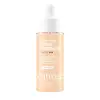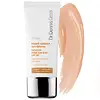Neutrogena Sensitive Skin Serum Foundation with Moisturizing Vitamin-B5 Versus Dr. Dennis Gross Skincare Instant Radiance Sun Defense Sunscreen Broad Spectrum SPF 40
What's inside
What's inside
 Key Ingredients
Key Ingredients

 Benefits
Benefits

 Concerns
Concerns

 Ingredients Side-by-side
Ingredients Side-by-side

Water
Skin ConditioningButylene Glycol Dicaprylate/Dicaprate
EmollientDimethicone
EmollientPhenyl Trimethicone
Skin ConditioningMethyl Trimethicone
Skin ConditioningGlycerin
HumectantLauryl PEG-10 Tris(Trimethylsiloxy)Silylethyl Dimethicone
EmulsifyingPentylene Glycol
Skin ConditioningOctyldodecyl Stearoyl Stearate
EmollientButylene Glycol
HumectantSodium Chloride
MaskingCetyl PEG/PPG-10/1 Dimethicone
EmulsifyingIsododecane
Emollient1,2-Hexanediol
Skin ConditioningPanthenol
Skin ConditioningTrimethylsiloxysilicate
EmollientDiphenylsiloxy Phenyl Trimethicone
Skin ConditioningPolymethylsilsesquioxane
Silica
AbrasiveDimethicone/Vinyl Dimethicone Crosspolymer
Skin ConditioningGlyceryl Caprylate
EmollientTribehenin
EmollientDisteardimonium Hectorite
StabilisingTriethoxycaprylylsilane
Disodium EDTA
Titanium Dioxide
Cosmetic ColorantIron Oxides
Mica
Cosmetic ColorantWater, Butylene Glycol Dicaprylate/Dicaprate, Dimethicone, Phenyl Trimethicone, Methyl Trimethicone, Glycerin, Lauryl PEG-10 Tris(Trimethylsiloxy)Silylethyl Dimethicone, Pentylene Glycol, Octyldodecyl Stearoyl Stearate, Butylene Glycol, Sodium Chloride, Cetyl PEG/PPG-10/1 Dimethicone, Isododecane, 1,2-Hexanediol, Panthenol, Trimethylsiloxysilicate, Diphenylsiloxy Phenyl Trimethicone, Polymethylsilsesquioxane, Silica, Dimethicone/Vinyl Dimethicone Crosspolymer, Glyceryl Caprylate, Tribehenin, Disteardimonium Hectorite, Triethoxycaprylylsilane, Disodium EDTA, Titanium Dioxide, Iron Oxides, Mica
Titanium Dioxide
Cosmetic ColorantZinc Oxide
Cosmetic ColorantWater
Skin ConditioningGlycerin
HumectantButylene Glycol
HumectantIsononyl Isononanoate
EmollientPentylene Glycol
Skin ConditioningCarthamus Tinctorius Seed Oil
MaskingOlea Europaea Fruit Oil
MaskingC12-15 Alkyl Benzoate
AntimicrobialCoconut Alkanes
EmollientHydroxyethyl Acrylate/Sodium Acryloyldimethyl Taurate Copolymer
Emulsion StabilisingAscorbyl Glucoside
AntioxidantMelatonin
AntioxidantTetrahexyldecyl Ascorbate
AntioxidantTocopherol
AntioxidantTocopheryl Acetate
AntioxidantNordihydroguaiaretic Acid
AntioxidantSodium Hyaluronate
HumectantPalmitoyl Tripeptide-38
Skin ConditioningEchium Plantagineum Seed Oil
Skin ConditioningOenothera Biennis Oil
EmollientBoerhavia Diffusa Root Extract
Skin ProtectingPhospholipids
Skin ConditioningSphingolipids
EmollientSaccharide Isomerate
HumectantCitrus Aurantium Dulcis Flower Extract
Skin ConditioningGlycolic Acid
BufferingSodium PCA
HumectantOleanolic Acid
Skin ConditioningPEG-60 Almond Glycerides
EmulsifyingHydrogenated Lecithin
EmulsifyingAcrylates/Carbamate Copolymer
Skin ConditioningBis-Ethylhexyl Hydroxydimethoxy Benzylmalonate
AntioxidantCoco-Caprylate/Caprate
EmollientAluminum Hydroxide
EmollientXanthan Gum
EmulsifyingCitric Acid
BufferingDisodium EDTA
Hydroxypropyl Cyclodextrin
MaskingSodium Citrate
BufferingCaprylyl Glycol
EmollientIsohexadecane
EmollientPolyhydroxystearic Acid
EmulsifyingSodium Hydroxide
BufferingTromethamine
BufferingBHT
AntioxidantPolysorbate 60
EmulsifyingCarbomer
Emulsion StabilisingIsopropyl Titanium Triisostearate
EmollientSorbitan Isostearate
EmulsifyingStearic Acid
CleansingBenzyl Alcohol
PerfumingPhenoxyethanol
PreservativePotassium Sorbate
PreservativeSodium Benzoate
MaskingCitrus Aurantium Dulcis Oil
MaskingMica
Cosmetic ColorantIron Oxides
Titanium Dioxide, Zinc Oxide, Water, Glycerin, Butylene Glycol, Isononyl Isononanoate, Pentylene Glycol, Carthamus Tinctorius Seed Oil, Olea Europaea Fruit Oil, C12-15 Alkyl Benzoate, Coconut Alkanes, Hydroxyethyl Acrylate/Sodium Acryloyldimethyl Taurate Copolymer, Ascorbyl Glucoside, Melatonin, Tetrahexyldecyl Ascorbate, Tocopherol, Tocopheryl Acetate, Nordihydroguaiaretic Acid, Sodium Hyaluronate, Palmitoyl Tripeptide-38, Echium Plantagineum Seed Oil, Oenothera Biennis Oil, Boerhavia Diffusa Root Extract, Phospholipids, Sphingolipids, Saccharide Isomerate, Citrus Aurantium Dulcis Flower Extract, Glycolic Acid, Sodium PCA, Oleanolic Acid, PEG-60 Almond Glycerides, Hydrogenated Lecithin, Acrylates/Carbamate Copolymer, Bis-Ethylhexyl Hydroxydimethoxy Benzylmalonate, Coco-Caprylate/Caprate, Aluminum Hydroxide, Xanthan Gum, Citric Acid, Disodium EDTA, Hydroxypropyl Cyclodextrin, Sodium Citrate, Caprylyl Glycol, Isohexadecane, Polyhydroxystearic Acid, Sodium Hydroxide, Tromethamine, BHT, Polysorbate 60, Carbomer, Isopropyl Titanium Triisostearate, Sorbitan Isostearate, Stearic Acid, Benzyl Alcohol, Phenoxyethanol, Potassium Sorbate, Sodium Benzoate, Citrus Aurantium Dulcis Oil, Mica, Iron Oxides
Ingredients Explained
These ingredients are found in both products.
Ingredients higher up in an ingredient list are typically present in a larger amount.
Butylene Glycol (or BG) is used within cosmetic products for a few different reasons:
Overall, Butylene Glycol is a safe and well-rounded ingredient that works well with other ingredients.
Though this ingredient works well with most skin types, some people with sensitive skin may experience a reaction such as allergic rashes, closed comedones, or itchiness.
Learn more about Butylene GlycolDisodium EDTA plays a role in making products more stable by aiding other preservatives.
It is a chelating agent, meaning it neutralizes metal ions that may be found in a product.
Disodium EDTA is a salt of edetic acid and is found to be safe in cosmetic ingredients.
Learn more about Disodium EDTAGlycerin is already naturally found in your skin. It helps moisturize and protect your skin.
A study from 2016 found glycerin to be more effective as a humectant than AHAs and hyaluronic acid.
As a humectant, it helps the skin stay hydrated by pulling moisture to your skin. The low molecular weight of glycerin allows it to pull moisture into the deeper layers of your skin.
Hydrated skin improves your skin barrier; Your skin barrier helps protect against irritants and bacteria.
Glycerin has also been found to have antimicrobial and antiviral properties. Due to these properties, glycerin is often used in wound and burn treatments.
In cosmetics, glycerin is usually derived from plants such as soybean or palm. However, it can also be sourced from animals, such as tallow or animal fat.
This ingredient is organic, colorless, odorless, and non-toxic.
Glycerin is the name for this ingredient in American English. British English uses Glycerol/Glycerine.
Learn more about GlycerinMica is a naturally occurring mineral used to add shimmer and color in cosmetics. It can also help improve the texture of a product or give it an opaque, white/silver color.
Serecite is the name for very fine but ragged grains of mica.
This ingredient is often coated with metal oxides like titanium dioxide. Trace amounts of heavy metals may be found in mica, but these metals are not harmful in our personal products.
Mica has been used since prehistoric times throughout the world. Ancient Egyptian, Indian, Greek, Roman, Aztec, and Chinese civilizations have used mica.
Learn more about MicaPentylene glycol is typically used within a product to thicken it. It also adds a smooth, soft, and moisturizing feel to the product. It is naturally found in plants such as sugar beets.
The hydrophilic trait of Pentylene Glycol makes it a humectant. As a humectant, Pentylene Glycol helps draw moisture from the air to your skin. This can help keep your skin hydrated.
This property also makes Pentylene Glycol a great texture enhancer. It can also help thicken or stabilize a product.
Pentylene Glycol also acts as a mild preservative and helps to keep a product microbe-free.
Some people may experience mild eye and skin irritation from Pentylene Glycol. We always recommend speaking with a professional about using this ingredient in your routine.
Pentylene Glycol has a low molecular weight and is part of the 1,2-glycol family.
Learn more about Pentylene GlycolTitanium dioxide is a mineral UV filter widely used in sunscreens and cosmetics.
It is one of only two UV filters officially classified as “mineral” by regulatory agencies, the other being zinc oxide.
Titanium dioxide provides broad-spectrum protection mostly in the UVB and UVAII range, with some protection in the UVAI range.
While its UVA protection isn’t as strong as zinc oxide’s, the difference is minor.
A common myth is that mineral UV filters reflect UV light. However, modern research shows titanium dioxide absorbs UV radiation like chemical filters (~95% absorption & 5% reflection).
Thanks to its non-irritating nature, titanium dioxide is suitable for sensitive, acne-prone, or redness-prone skin. It is unlikely to cause "eye sting" like other sunscreen ingredients.
A major drawback of this ingredient is its white cast and thick texture. This is why mineral sunscreens often leave a white cast and are less cosmetically elegant than chemical/hybrid sunscreens.
To improve white cast and spreadability, micronized or nano-sized titanium dioxide is often used.
There are ongoing concerns surrounding nano-titanium oxide's impact on marine ecosystems.
There is no conclusive evidence that any form of titanium oxide (or any other sunscreen ingredients) will cause harm to marine ecosystems or coral reefs. The science is still developing but many consumers are keeping a close eye on this issue.
Please note, many destinations have reef-safety sunscreen rules. For instance, the U.S. Virgin Islands advises all visitors to use non-nano mineral sunscreens.
Nano mineral sunscreens once raised safety concerns about absorption into skin.
Extensive research has shown that they do not penetrate healthy or damaged skin; they remain safely on the surface and the top layer of dead skin (stratum corneum).
You'll likely find titanium dioxide bundled with alumina, silica, or dimethicone. These ingredients help make titanium dioxide highly photostable; this prevents it from interacting with other formula components under UV light.
Learn more about Titanium DioxideWater. It's the most common cosmetic ingredient of all. You'll usually see it at the top of ingredient lists, meaning that it makes up the largest part of the product.
So why is it so popular? Water most often acts as a solvent - this means that it helps dissolve other ingredients into the formulation.
You'll also recognize water as that liquid we all need to stay alive. If you see this, drink a glass of water. Stay hydrated!
Learn more about WaterThis ingredient is a combination of red, black, and yellow iron oxide pigments. This combination of colors is usually found in foundation, because it results in a "skin" color.